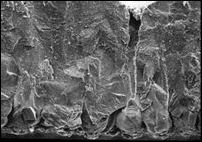



Eggshell clues for reducing poultry stress and commercial losses
By The Biotechnology and Biological Sciences Research Council (BBSRC) - An unusual collaboration between biologists and earth scientists, at the University of Glasgow Veterinary School, has shown how stress can disrupt the carefully programmed insertion of proteins into an eggshell, resulting in poor shell quality and reduced egg value.
The findings could lead to a non-invasive way of identifying subtle causes of stress associated with different poultry management systems.
They might also be used in conjunction with genetic information about stress susceptibility, to help egg producers to identify the best combinations of breed and system for good animal welfare and quality egg production.
The shell of a hen's egg is composed almost entirely of calcium carbonate (around 95%) in association with phosphorus and trace amounts of magnesium. A variety of different proteins are also present, accounting in total for about 2% of the shell.
“It turns out that these small amounts of protein are critically important in determining shell structure ”says Professor Sally Solomon who heads the Poultry Research Unit at Glasgow." They are produced during the 20 hours or so during which the calcium carbonate is laid down on the membrane that surrounds the egg white, and they have to be incorporated in precisely the right way”.
The importance of the proteins emerged both from international collaboration and from an interdisciplinary study between biologists Drs Maureen Bain and Alex Fraser with Dr Margaret Cusack of Earth Sciences, which was designed to explore the morphology and mechanical properties of eggshells from lines of breeder hens.
“We chose to look at commercial breeding hens reared and kept under high quality conditions because they are under less productive stress than commercial layers ”, explains Professor Solomon." We found a surprisingly high level of stability in shell formation and quality compared with layers, with far fewer structural defects in shells. The protein components of the shell influence its morphology, and we are now exploring the role of individual shell specific proteins ”.
Professor Solomon believes that the results from the breeder hens provide useful pointers to understanding what can go wrong in shell production in commercial layers which are required to produce an egg every 24 hours and which typically show a decline in shell quality as they get older. She is particularly interested in how changes in shell formulation may be used to identify the stresses that caused them.
Shell quality and conservation
Understanding the factors that determine the structure and integrity of eggshells has some surprising applications. For example, diet is known to exert an effect, and in the captive rearing of endangered species it is important that shell quality is carefully monitored viz marine turtles fed a calcium rich diet produced heavy calcitic eggs which failed to hatch. Pollutants have been shown to have the reverse effect, thus DDT caused shell thinning in the eggs of many wild birds with catastrophic effects on hatchability.
Stress effects
At its simplest, egg production involves the egg yolk travelling from the ovary along the oviduct to the eggshell pouch from which the finished egg is laid. As it is pumped along on its journey by muscle contractions, in a way reminiscent of food moving through the gut of a mammal, the yolk accumulates layers of albumen (egg white)and its shell as the result of the activity of cells that line the oviduct and the pouch. If the hen suffers from stress the secretions of these cells can become acidic and there may be localised damage and destruction of cells with consequent loss of function -a process that again resembles stress-associated acid reflux in the gut. In extreme cases, such stress induced effects can result in eggshells that have excess deposits of calcium -a sort of powdery “bloom” on the surface, or are misshapen and unsaleable at retail. Although nutritionally unaffected, such eggs can be sold only for baking and further processing and so are of reduced value for the producer.
Stress-induced defects in shells are estimated to cost the world’s poultry industry in excess of $6M each year.
“Hens can acclimatise themselves to their conditions but are still vulnerable to sudden unexpected ‘shocks’ . Individual birds react differently from each other and it is sometimes possible to see a ripple effect in flocks as one or two birds respond to a stress and trigger others to do so ”says Professor Solomon.
The Glasgow researchers believe that they will be able to use their new understanding of how stress affects eggshell quality (a) to identify hitherto hidden causes of stress, and (b) to identify breeds that can cope best with the different stresses that arise in cage, perchery (barn) and free range systems of production.
“As the European Union moves to more egg production in open environments, it is important to be able to identify how stresses such as risk from predators, feather pecking in large flocks and reaction to climate changes, impact on bird welfare and egg quality ”says Professor Solomon." Modern breeds and strains that have been bred for more intensive production may fare less well than more traditional breeds. Monitoring egg quality could give an easy guide to best practice in terms of husbandry systems, diet, breed, stocking density and conditions. This would improve welfare and save the industry money at the same time ”.
Eggshell as a material
Eggshell, rather like spidersilk, is one of those rather mysterious natural materials that exhibits a range of useful properties that might be exploited industrially -if only we fully understood the principles of its construction. Research in Professor Solomon's group, funded by the Engineering and Physical Sciences Research Council, is aimed at understanding the mechanics of eggshell and the relationships between shell structure and properties such as strength, porosity and flexibility.

An electron micrograph showing the cross-section of an eggshell.
January 2002








